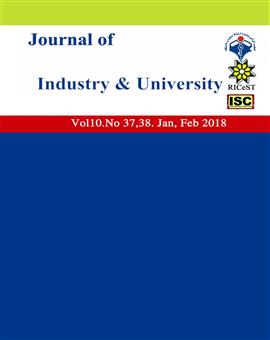The relationship between corporate social responsibility and competitive advantage (Case study: industrial group selection)
Subject Areas : عمومىzohre fehrest 1 * , Hadi Teimouri 2 , reza ansari 3
1 -
2 -
3 - Ferdosi University
Keywords:
Abstract :
Definitely Corporate Social Responsibility in today's competitive world in various fields of business is crucial position due to changes in global markets and sustain competitive advantage for manufacturing companies is very difficult.It was once thought that organizations are responsible solely to the staff or to be the best consumer products, lower prices and higher quality to their customers.Secondary consequences for not knowing what the product is, today, giving customers an organization of life-giving organizations to continue to operate in competition with others counts. . The present study is applied in terms of purpose applicability and based on the data collection methodnd descriptive and survey type. Required data with questionnaire the customers of Isfahan Selection Industrial Group are gathered and In order to analyze the data, structural equations were used. The results of the research show there is a relationship between dimensions of social responsibility and competitive advantage the organization has taken various social responsibility measures to raise its intellectual capital And it makes the organization different.
1-دارائي محمدرضا ; پارساعمل, الهه(1392)،" بررسي تاثير فرهنگ سازماني بر مسئوليت اجتماعي در شركت خودروسازي سايپا". فصلنامه مديريت دولتي ، سال پنجم، شماره 16.
2Inoue, Y., Lee, S., (2011).“Effects of different dimensions of corporate social responsibility on corporate financial performance in tourism-related industries”. Journal of Tourist Management. Vol. 32, No. 4, pp. 790-804.
3Fua,H. Haobin Ye,B, Lawb R (2014) .”You do well and I do well? The behavioral consequences of corporate social responsibility” .International Journal of Hospitality Management. Vol. 40, No. 1, pp. 62-70.
-4Carroll, A.B., (1991)."The pyramid of corporate social responsibility : toward the moral management of organizational stakeholders" .Journal of Business . Vol. 7, No. 8, pp. 39-48.
5Carroll, A.B., (1979). A three-dimensional conceptual model of corporate performance Acad. Journal of Management.Vol. 4, No. 4, pp. 497-505.
6-طبرسا، غلامعلي; رضائيان، علي ;آذر;عادل ، عليخاني,- حميد; (1392)."تبيين و طراحي مدل رسالت مسئوليت اجتماعي سازمان". فصلنامه مطالعات مديريت راهبردي ، سال دوم، شماره 8.
7Aras G, CrowtherD(2010). Sustaining business excellence.Journal of Management.Vol. 5, No. 21, pp. 565-76.
8Pätäri,S-Arminen,H. Tuppura, A- Jantunen,A (,2014). ”Competitive and responsible? The relationship between corporate social and financial performance in the energy sector”. Journal Renewable and Sustainable Energy Reviews. Vol. 37, No. 1, pp. 142-154.
9SayedehSaeidi ,P Sofiana, S Saeidi P SayyedehSaeidi,PSeyyedSaaeidi A (2014) .”How does corporate social responsibility contribute to firm financial performance”? The mediating role of competitive advantage, reputation, and customer satisfaction .Journal of Business Research. Vol. 1, No. 1, pp. 28-38.
10Dunk, A. S. (2007). Assessing the effects of product quality and environmental management accounting on the competitive advantage of firm. Australasian Accounting Business & Finance Journal, Vol. 1, No. 1, pp. 28-38.
11Quairel-Lanoizelée,F(2011),"Are competition and corporate social responsibility compatible?"Journal Society and Business Review. Vol. 6, No. 1, pp. 77-98.
12Billaudot, B. (2008), “Lectures institutionnelles de la RSE”.Journal of Management.Vol. 16, No. 1, pp. 56-65.
13 Williams, P., &Naumann, E. (2011). Customer satisfaction and business performance: A firm-level analysis. Journal of Services Marketing. Vol. 25, No. 1, pp. 20-32.
14Ambastha, A. and K. Momaya: (2004) .Competitiveness of Firms: Review of Theory, Frameworks and Models’. Journal of Management.Vol. 26, No. 1, pp. 46-61.
15Hill, C. W. and T. M. Jones (1992).“Stakeholder-Agency Theory”.Journal ofManagement Studies, Vol. 29, No. 2, pp. 131-154.
16Farooq O, PayaudM ,Merunka D (2013).”The Impact of Corporate Social Responsibility on Organizational Commitment: Exploring Multiple Mediation Mechanisms”.Journal of Business Ethics.Vol. 125, No. 4, pp. 563-580.
17Wood, D. J. (2010).Measuring corporate social performance: A review. International Journal of Management. Vol. 12, No. 1, pp. 50-84.
18Orlitzky, M., Siegel, D. S., &Waldman, D. A. (2011).Strategic corporate social responsibilityand environmental sustainability. Business & Society, 50(1), 6–27. Vol. 1, No. 1, pp. 28-38.
19Chen, F. Y., Chang, Y. H., & Lin, Y. H. (2012).Customer perceptions of airline social responsibilityand its effect on loyalty.Journal of Air Transport Management,.Vol. 20, No. 1, pp. 49-11.
20Lee, C.K., Song, H.J., Lee, H.M., Lee, S., Bernhard, B.J.,( 2013). The impact of CSR oncasino employees’ organizational trust, job satisfaction, and customer orientation: an empirical examination of responsible gambling strategies. Journal Hospital Management. Vol. 33, No. 0, pp. 406-415.
21-طیبی رهنی، علی؛ جزنی، نسرین(1395)، " ارتقاء حقوق شهروندی سازمان با تحقق مسئولیت اجتماعی".همایش مسئولیت اجتماعی شرکت-مسئولیت اجتماعی صنعت نفت.سال اول،شماره12.
22-يونسي دل ارام, سعيدا سعيد, موسوي جد محمد, قاسمي افشين(1394)"خلق مزيت رقابتي منبع محور پايدار براي نظام بانکي".مجله کاوشهای مدیریت بازرگانی، دوره7 , شماره 13 ، صص75-95.
23Gallardo-Vázquez, D , Sanchez-Hernandez, M. Isabel (2014).” Measuring Corporate Social Responsibility for competitive success at a regional level”.Journal of Business Ethics. Vol. 72, No. 1, pp. 14-22.

